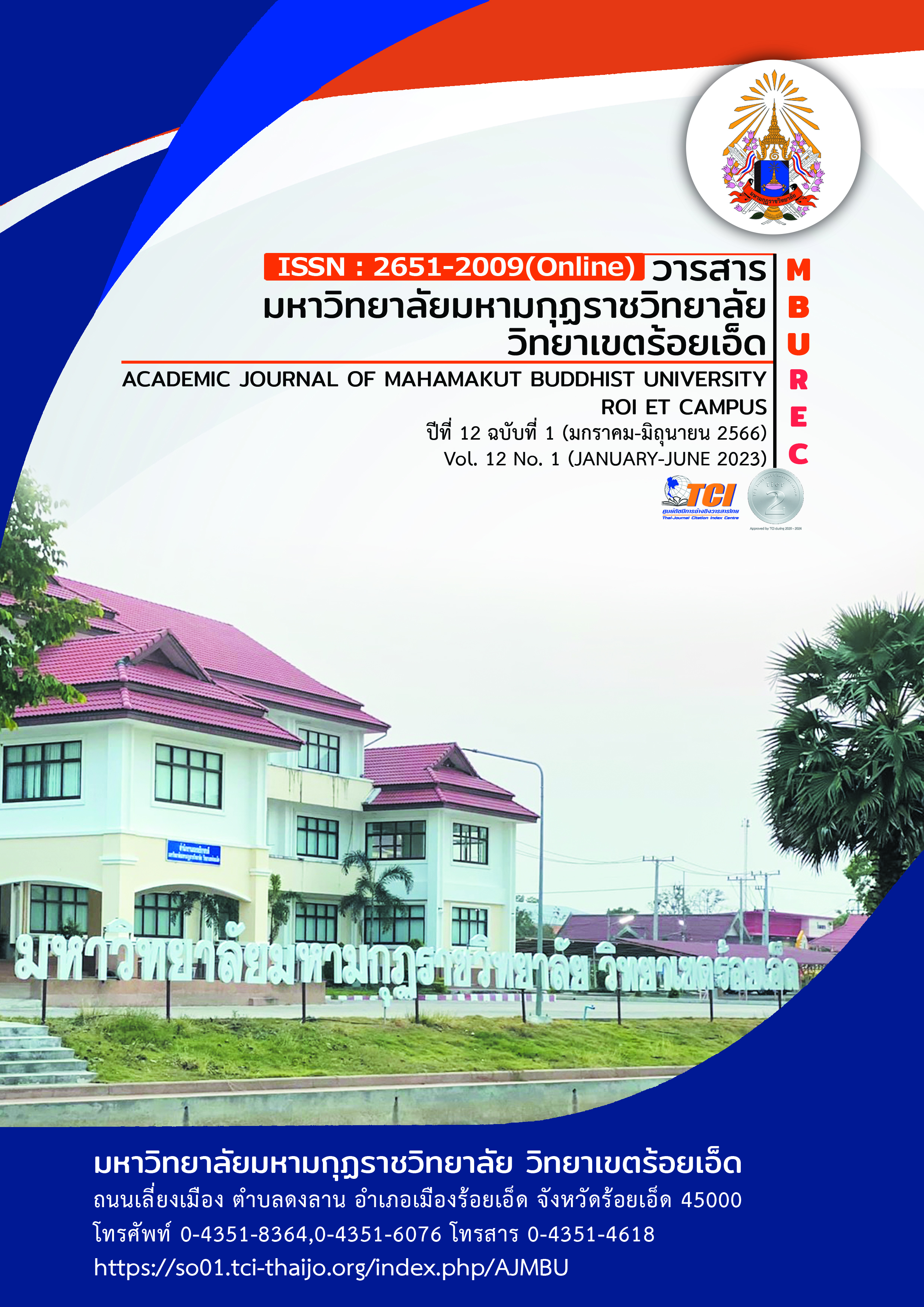THE DEVELOPMENT OF LINEAR MOTION CONCEPTUAL TEST TO ASSESS LINEAR MOTION CONCEPT USING ITEM RESPONSE THEORY FOR MATTHAYOMSUKSA 4
Main Article Content
Abstract
The objectives of this research were 1) To construct the Linear Motion Conceptual Test 2) To check the quality of the Linear Motion Conceptual Test 3) To determine the intersection points of the Linear Motion Conceptual Test and 4) To develop a user manual for Linear Motion Conceptual Test by applying the three-parameter Item Response Theory for Matthayomsuksa 4. The operation is divided into 4 phases, according to objectives. The sample of this research was 411 Matthayomsuksa 4 students in the 2nd semester of 2021 academic year. A sample group was selected from 1,381 students by using Multi-stage Sampling. The research tool was of the Linear Motion Conceptual Test by applying the three-parameter Item Response Theory which was the three-tier multiple choices. Descriptive statistics were used for data analysis. There was frequency, percentage, mean, difficulty, discrimination, content validity and reliability.
The results of the research follow: 1. The results of the construction of the Linear Motion Conceptual Test which was three-tier multiple choices could be created 10 questions to measure of 7 concepts in physics about linear motion they consisted of 1 questions of positional, 2 questions of distance and displacement, 1 questions of speed and velocity, 2 questions of acceleration,1 questions of the relationship between displacement velocity and time, 2 questions of straight motion with constant acceleration and 1 questions of free fall. 2. The results of the quality examination of the Linear Motion Conceptual Test. The Index of Index of Item Objective (IOC)of the quality question was between 0.80-1.00, discrimination (B-index) was between 0.21 to 0.65, discrimination parameter was between 0.91 to 2.48, difficulty parameter was between -0.64 to 2.04, guessing parameter was between – 9.57 to 0.30 and the reliability was 0.81. 3. The Cutting Score of the Linear Motion Conceptual Test were the intersection point between the scientific knowledge student and the misconception student was 12 points and the intersection between the misconception students and the lack of knowledge students was 3 points, 4. The result of creating a user manual of the Linear Motion Conceptual Test by applying the three-parameter Item Response Theory were getting manual of the Linear Motion Conceptual Test which teachers could use for the exam administration. The manual of the Linear Motion Conceptual Test, content validity index was 0.80.
Article Details

This work is licensed under a Creative Commons Attribution-NonCommercial-NoDerivatives 4.0 International License.
References
กระทรวงศึกษาธิการ. (2551). หลักสูตรแกนกลางการศึกษาขั้นพื้นฐาน พุทธศักราช 2551. กรุงเทพมหานคร : โรงพิมพ์คุรุสภา.
ธนธัญ ฝีมือสาร. (2559). ผลของกลวิธีการสอนสี่ขั้นตอนตามแรวคอนสตรัคติวิสต์ที่มีต่อมโนมติฟิสิกส์และเจตคติต่อการเรียนฟิสิกส์ของนักเรียนชั้นมัธยมศึกษาปีที่ 5. วิทยานิพนธ์ปริญญาครุศาสตรมหาบัณฑิต สาขาวิชาการศึกษาวิทยาศาสตร์. จุฬาลงกรณ์มหาวิทยาลัย.
บังอร สวนพลู. (2560). การพัฒนาแบบวัดความคิดรวบยอดทางคณิตศาสตร์สำหรับนักเรียนชั้นมัธยมศึกษาปีที่ 3 สังกัดสำนักงานเขตพื้นที่การศึกษาประถมศึกษาปทุมธานี เขต 2. วิทยานิพนธ์ปริญญาศึกษาศาสตรมหาบัณฑิต สาขาการวิจัยและวัดประเมินผลการศึกษา. มหาวิทยาลัยเกษตรศาสตร์.
บุญใจ ศรีสถิตย์นรากูร. (2550). ระเบียบวิธีการวิจัยทางพยาบาลศาสตร์. พิมพ์ครั้งที่ 4. กรุงเทพมหานคร : ยูแอน์ไอ อินเตอร์มีเดีย.
บุญชม ศรีสะอาด. (2545). การวิจัยเบื้องต้น. พิมพ์ครั้งที่ 7. กรุงเทพมหานคร : สุวีริยาสาส์น.
ประสพชัย พสุนนท์. (2558). ความเที่ยงตรงของแบบสอบถามสำหรับงานวิจัยทางสังคมศาสตร์. วารสารสังคมศาสตร์ มหาวิทยาลัยศรีนครินทรวิโรฒ. 18(1). 375-396.
ปัทมาพร ณ น่าน. (2561). การสร้างแบบทดสอบวินิจฉัยมโนทัศน์ที่คลาดเคลื่อนแบบสามชั้นวิชาฟิสิกส์ เรื่อง แรงและกฎการเคลื่อนที่สำหรับนักเรียนระดับชั้นมัธยมศึกษาปีที่ 4. วิทยานิพนธ์ปริญญาวิทยาศาสตรมหาบัณฑิต สาขาวิชาวิจัย วัดผลและสถิติการศึกษา. มหาวิทยาลัยบูรพา.
พิชิต ฤทธิ์จรูญ. (2551). ระเบียบวิธีการวิจัยทางสังคมศาสตร์. พิมพ์ครั้งที่ 4. กรุงเทพมหานคร : เฮาส์ออฟเฮอร์มิส.
ไพศาล วรคำ. (2558). การวิจัยทางการศึกษา. พิมพ์ครั้งที่ 7. มหาสารคาม : ตักสิลาการพิมพ์.
มิ่ง เทพครเมือง. (2554). การตรวจสอบความเท่าเทียมกันของการวัดบนพื้นฐานทฤษฎีการทดสอบแบบคะแนนจริงสัมพันธ์และทฤษฎีการตอบข้อสอบ. วิทยานิพนธ์ปริญญาการศึกษาดุษฎีบัณฑิต สาขาการทดสอบและวัดผลการศึกษา. มหาวิทยาลัยศรีนครินทรวิโรฒ.
ศิริชัย กาญจนวาสี. (2556). ทฤษฎีการทดสอบแบบดั้งเดิม. พิมพ์ครั้งที่ 7. กรุงเทพมหานคร : สำนักพิมพ์แห่งจุฬาลงกรณ์มหาวิทยาลัย.
ศิริชัย กาญจนวาสี. (2563). ทฤษฎีการทดสอบแนวใหม่. พิมพ์ครั้งที่ 5. กรุงเทพมหานคร : สำนักพิมพ์แห่งจุฬาลงกรณ์มหาวิทยาลัย.
ศิริพันธ์ ติยะวงศ์สุวรรณ. (2554). การพัฒนาวิธีการกำหนดคะแนนจุดตัดสำหรับการทดสอบทางการศึกษาระดับชาติขั้นพื้นฐานวิชาคณิตศาสตร์ และวิทยาศาสตร์ ของนักเรียนมัธยมศึกษาปีที่ 6. วิทยานิพนธ์ปริญญาครุศาสตรดุษฎีบัณฑิต สาขาวิชาการวัดและประเมินผลการศึกษา. จุฬาลงกรณ์มหาวิทยาลัย.
สถาบันทดสอบทางการศึกษาแห่งชาติ. (2555). การกำหนดจุดตัดคะแนนผลสอบ O-NET มัธยมศึกษาปีที่ 6 ปีการศึกษา 2554. NIETS News. 34. 9-11.
สถาบันทดสอบทางการศึกษาแห่งชาติ. (2558). O-NET (Ordinary National Educational Test). สืบค้นเมื่อ 28 สิงหาคม 2563. จาก https://www.niets.or.th/th/catalog/view/211
สำนักงานคณะกรรมการการศึกษาขั้นพื้นฐาน. (2560).ตัวชี้วัดและสาระการเรียนรู้แกนกลางกลุ่มสาระการเรียนรู้วิทยาศาสตร์ (ฉบับปรับปรุง พ.ศ.2560) ตามหลักสูตรแกนกลางการศึกษาขั้นพื้นฐาน พุทธศักราช 2551. กรุงเทพมหานคร : โรงพิมพ์ชุมนุมสหกรณการเกษตรแห่งประเทศไทย จำกัด.
สุชาดา กรเพชรปาณี และคณะ. (2557). รายงานการวิจัย เรื่อง การพัฒนาโปรแกรมการทดสอบแบบปรับเหมาะด้วยคอมพิวเตอร์ สำหรับการจัดสอบ O-NET. กรุงเทพมหานคร : สถาบันทดสอบทางการศึกษาแห่งชาติ (องค์การมหาชน).
สุนิสา จันทร์พล. (2555). การพัฒนามโนมติฟิสิกส์ เรื่อง เสียง โดยใช้การจัดการเรียนรู้วิทยาศาสตร์สืบเสาะแบบเปิดผ่านสถานการณ์จำลองบนคอมพิวเตอร์ ตามกรอบโมเดลการเรียนรู้แบบคู่ควบ. วิทยานิพนธ์ปริญญาศึกษาศาสตรมหาบัณฑิต สาขาวิทยาศาสตร์ศึกษา. มหาวิทยาลัยขอนแก่น.
อุมาวรรณ แสงสนิท. (2557). การพัฒนาแบบทดสอบมาตรฐานวัดผลสัมฤทธิ์ทางการเรียนวิชาเทคโนโลยีสารสนเทศ เรื่ององค์ประกอบของคอมพิวเตอร์ โดยประยุกต์ใช้ทฤษฎีการตอบสนองข้อสอบ สำหรับนักเรียนชั้นมัธยมศึกษาปีที่ 1 สังกัดสำนักงานเขตพื้นที่การศึกษามัธยมศึกษา เขต 9 จังหวัดสุพรรณบุรี. วิทยานิพนธ์ปริญญาครุศาสตรมหาบัณฑิต สาขาวิชาวิจัยและประเมินผลการศึกษา. มหาวิทยาลัยราชภัฏกาญจนบุรี.
Arslan, H. O., Cigdemoglu, C. & Moseley, C. (2012). A Three-Tier Diagnostic Test to Assess Pre-Service Teachers’ Misconceptions about Global Warming, Greenhouse Effect, Ozone Layer Depletion, and Acid Rain. International Journal of Science Education. 34(11). 1667-1686.
Hassard and Dias. (2008). The art of teaching science inquiry and innovation in middle school and high school. New York : Routledge.
Livingston, S.A. (1972). A Criterion – Referenced Application of Classical Test Theory, Journal of Educational Measurement. 9. 13-26.
Odom, A. L., & Kelly, P. V. (2001). Integrating concept mapping and the learning cycle to teach diffusion and osmosis concepts to high school biology students. Science Education. 85(6). 615-635.
Yamane, Taro. (1967). Statistics, An Introductory Analysis. 2nd ed. New York : Harper and Row.


